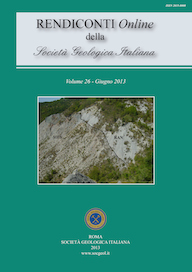
Le Brecce argillose di Musigliano (Appennino Vogherese – Tortonese): dati stratigrafici preliminari
Filippo Panini (*), Chiara Fioroni (*) & Paola Fregni (*)
(*) Dipartimento di Scienze Chimiche e Geologiche, Università di Modena e Reggio Emilia. P.le S. Eufemia 19, 41100 Modena. E-mail: filix@unimore.it
DOI: https://doi.org/10.3301/ROL.2013.14
Volume: 26/2013
Pages: 21-31
Abstract
The Musigliano argillaceous Breccias (Voghera and Tortona Apennines): preliminary stratigraphic data.
An integrated biostratigraphic study based on foraminifers and calcareous nannofossils has been performed on two chaotic bodies involved within the Epiligurian pelitic sequence outcropping in the Alessandria and Pavia Apennines (M. Penola & M. Vallassa area), allowing to define the age of their emplacement. The investigated deposits mainly consist of strongly tectonized sediments ensuing from the Ligurian substratum mainly through submarine cohesive mud flows and lithic debris. These chaotic bodies have been previously considered (Gelati et al., 1974; Gelati & Vercesi, 1994) as involved within the Antognola Formation and correlated with similar Lower Miocene deposits widespread in Northern Apennines (Canossa Olistostrome, Val Tiepido-Canossa argillaceous Breccias). Dissenting from previous interpretations, our study shows that these chaotic bodies, named here as “Musigliano argillaceous Breccias” were displaced in an interval between Late Eocene and Early Oligocene. In fact, the biostratigraphic analyses of the marlstones under the chaotic bodies indicate they are attributable to the P15 and P16 planktonic foraminifer biozones of Berggren et al., (1995) corresponding to the G. semiinvoluta and T. cerroazulensis biozones of Mancin et al. (2003). The same pelitic rocks are relatable to the MNP19/20 nannofossil biozone of Catanzariti et al. (1997), corresponding to the NP19/20 of Martini (1971). The Epiligurian marlstones and turbiditic mudstones upon the Musigliano argillaceous Breccias fall in the P19 p.p. / P20 (corresponding to the G. ampliapertura biozone, Mancin et al., 2003) corresponding to the MNP23 biozone (Catanzariti et al., 1997) and to the NP23 biozone of Martini(1971). We correlate the pelitic rocks under the Musigliano argillaceous Breccias to the uppermost part of the Monte Piano Marls (“grey lithofacies” according to Mancin & Cobianchi, 2000 and Panini et al., 2002), and the marlstones and turbiditic mudstones upon the sedimentary chaotic bodies to the Ranzano Formation, on the basis of lithologic features and age. The displacement of the Musigliano chaotic breccias marks a strong stratigraphic break in the Epiligurian sequence; it could be related to events (probably of tectonic nature) previously reported as affecting the lower part of the Epiligurian succession and the coeval sequence of the Tertiary Piedmont Basin (Mutti et al., 1995; Catanzariti et al.,1997; Martelli et al., 1998; Ottria et al., 2001). As in the Emilia south-easternmost Apennines, the Oligocene-Lower Miocene Epiligurian sedimentary record seems to be devoid of typical resedimented arenaceous bodies generally characterizing the Ranzano Formation also in the studied area.
Keywords
Northern Apennines, Epiligurian succession, chaotic rock bodies, argillaceous breccias, planktonic foraminifers, calcareous nannofossils, Biostratigraphy, Eocene, Oligocene
Get Full Text